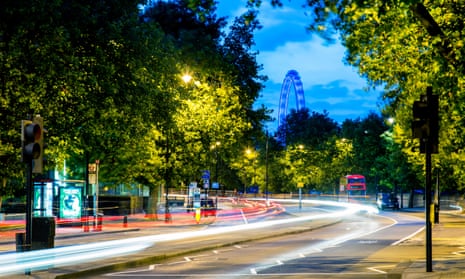City trees, popularly thought to remove pollutants and improve urban life, may also increase the amount of foul air that people breathe, says the UK body which gives independent health guidance to national and local government.
“Leaves and branches slow air currents, causing pollutants to settle. They may also act as sinks for particulates and chemicals that may have direct or indirect effects in air quality. Air quality [under trees] may deteriorate at street level near vehicles,” says the National Institute for Health and Care Excellence (Nice) in new draft guidance for local government to combat air pollution.
Nice does not recommend that councils cut down trees in leafy suburbs to meet pollution limits, but urges planners, local authorities and developers to take into account the adverse effect that trees can have on air quality if badly sited or unmanaged.
“It is not always true that trees reduce air pollution. Their effect is dependent on factors including species, canopy density, time of year and wind direction. Ventilation [on streets] will vary according to the size, distribution and species of tree and their position,” it says.
The guidelines also question the unintended consequences of other measures often taken by cities to improve people’s quality of life. Road humps aimed at slowing traffic and noise barriers erected alongside busy roads can both increase air pollution, says Nice.
“Traffic calming measures such as speed humps ... may increase emissions by adding to decelerations and accelerations,” it says. “Ensuring motorists drive steadily at the optimum speed can reduce stop-go driving and reduce emissions.
“People regularly travelling or living downwind of a plume of vehicle pollution can experience poorer air quality as a result of a solid barrier.”
The 60-page report, which goes to consultation on Thursday and could be adopted by July, is expected to feed into the government’s response to the supreme court. Following several cases brought by law firm ClientEarth, the court has demanded faster action to reduce air pollution which causes more than 40,000 early deaths a year in Britain, with conservative estimates putting the cost at between £8.5bn-£18.6bn.
Under pressure from the courts, the government has proposed clean air zones in five cities, including Birmingham, Derby, Leeds, Nottingham and Southampton. But Nice recommends that all councils consider setting up similar zones which could allow them to ban heavily polluting vehicles from town centres, and set their own pollution standards for taxis, hire vehicles and council fleets.
It proposes that councils consider air pollution at every stage of the planning process. This could extend to where new housing is sited and recommending that developers build new houses with the living room situated furthest away from roads.
Schools and nurseries should be sited away from main roads and councils should avoid developments that trap pollution in canyons, says Nice. But it also wants to see drivers educated as to how to reduce emissions. New guidelines are expected to support low and zero emission travel.
“Public sector transport providers should educate drivers how to reduce emissions. This could include switching the engine off when they are dropping people off, or making deliveries, and avoiding rapid accelerations and decelerations,” said a spokesman.
However, the committee could not directly address the sheer number of cars now on roads and was limited to proposing ways to mitigate pollution.
“We can take steps now to encourage people to walk or cycle rather than drive but these efforts will be futile if we do not have a long-term plan to improve air quality,” said Mark Baker, director for the centre of clinical practice at Nice.
“Past measures have not had the required impact. The draft guidance sets out ... practical measures for local authorities to encourage low or zero emission transport,” said Paul Lincoln, chair of the Nice guidelines committee.
A British Lung Foundation spokesperson said: “Robust measures must be taken to clean up the air we breathe. We need to specifically target the most polluted areas in our towns and cities. Everyone deserves to breathe clean air.”
“Action is needed both to ensure vehicles on the road are clean and that there are fewer of them. Diesel vehicles, which are the most polluting, must be phased out and our transport and planning policy needs a radical overhaul,” said a spokeswoman for Friends of the Earth.
“This is no time for tinkering around the edges – to deal with this public health crisis we must plan our towns and cities in ways which actually reduce traffic and give people real alternatives to driving.”

Comments (…)
Sign in or create your Guardian account to join the discussion